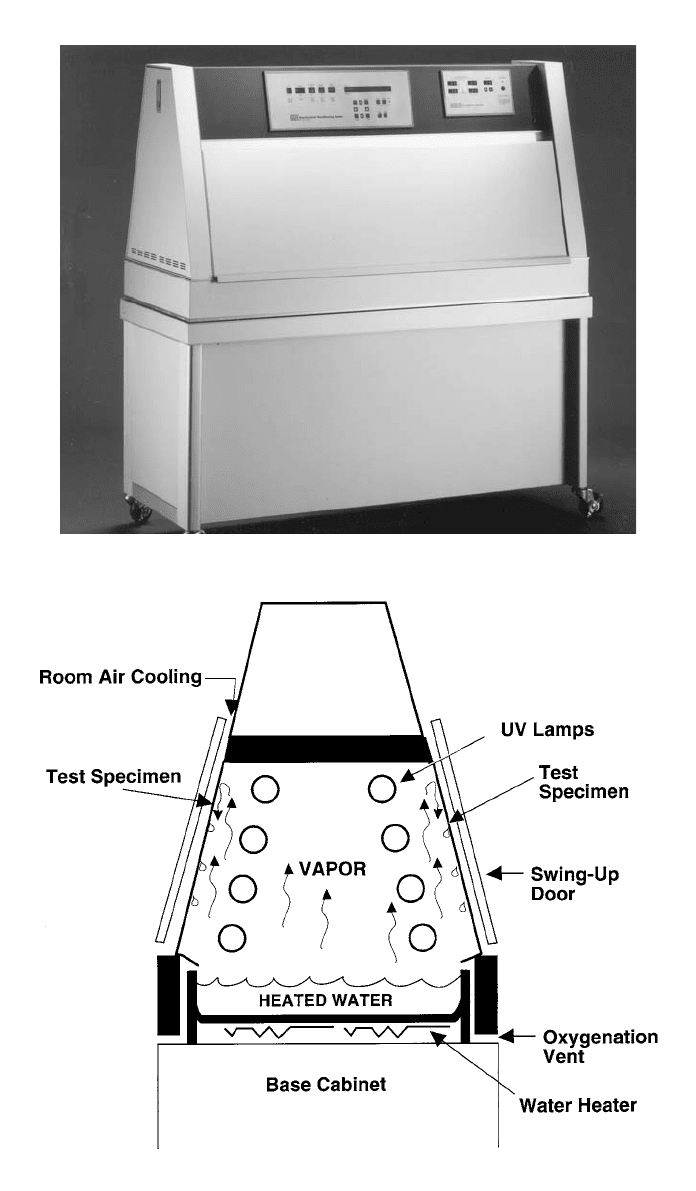Kutz M. Handbook of materials selection
Подождите немного. Документ загружается.


578 PLASTICS TESTING
between them that is distributed through the volume of the specimen. Or, simply
stated, the volume resistance is the resistance to leakage through the body of
the material. Volume resistance generally depends upon the material. The term
most commonly used by designers is volume resistivity. It is defined as the ratio
of the potential gradient parallel to the current in the material to the current
density or, simply stated, the volume resistivity of a material is the electrical
resistance between the opposite faces of a unit cube for a given material and at
a given temperature.
High-volume resistivity materials are desirable in applications requiring su-
perior insulating characteristics.
The surface resistance of a material is defined as the ratio of the direct voltage
applied to the electrodes to that portion of the current between them that is
primarily in a thin layer of moisture or other semiconducting material that may
be deposited on the surface. Simply stated, surface resistance is the resistance
to leakage along the surface of an insulator. The surface resistance of a material
depends upon the quality and cleanliness of the surface of the product. A product
with oil or dirt particles on it gives lower surface resistance values.
The test procedures to determine electrical resistance values are rather com-
plex. ASTM D257 (IEC 93) describes the procedures as well as the complex
electrodes and apparatus required to carry out the test in detail.
Temperature and humidity both seem to affect the insulation resistance ap-
preciably. As a rule, the higher the temperature and humidity, the lower the
insulation resistance of a material.
3.4 Arc Resistance (ASTM D495)
Arc resistance is the ability of a plastic material to resist the action of a high-
voltage electrical arc, usually stated in terms of time required to form material
electrically conductive. Failure is characterized by carbonization of the surface,
tracking, localized heating to incandescence, or burning. In all applications in
which conducting elements are brought into contact, arcing is inevitable.
Switches, circuit breakers, and automotive distributor caps are a few good ex-
amples of applications where arcing is known to cause failure. Another term
that is generally associated with arcing is tracking. Tracking is defined as a
phenomenon where a high-voltage source current creates a leakage or fault path
across the surface of an insulating material by slowly but steadily forming a
carbonized path appearing as a thin, wiry line between the electrodes. Tracking
is accelerated by the presence of surface contaminants such as dirt and oil and
by the presence of moisture. Resistance to arcing or tracking depends upon the
type of plastic materials such as phenolics that tend to carbonize easily and
therefore have relatively poor arc resistance. Plastics such as alkyds, melamines,
and fluorocarbons are excellent arc-resistant materials. The failures due to arcing
are not always because of carbonization or tracking. Many plastics such as acryl-
ics simply do not carbonize. However, they do form ignitable gases that cause
the product to fail in a short time. Arc resistance of plastics can be improved
substantially by the addition of fillers such as glass, mineral, wood flour, asbes-
tos, and other inorganic fillers. Table 3 lists the arc resistance of some common
plastic materials.
The determination of the arc resistance of plastics using a standard test
method has always been a problem because of the numerous ways the test can

3 ELECTRICAL PROPERTIES 579
Table 3 Arc Resistance of Various Plastics
Plastics
Arc Resistance
(sec)
Polycarbonate (10–40 percent glass filled) 5–120
Polycarbonate 10–120
Polystyrene (high impact) 20–100
ABS 50–85
Polystyrene (general purpose) 60–80
Rigid polyvinyl chloride 60–80
Polysulfone 75–190
Urea formaldehyde 80–150
Ionomer 90–140
SAN 100–150
Epoxy 120–150
Acetal (homopolymer) 130
Polyethylene (low-density) 135–160
Polypropylene 135–180
PTFE
⬎200
Acrylics No track
be conducted. ASTM has developed four basic test methods to satisfy this con-
cern. ASTM D495, which is high-voltage, low-current, dry arc resistance of solid
electrical insulation, has been the most widely used and accepted. This test is
only intended for the preliminary screening of materials, for detecting the effect
of changes in formulations, and for quality control testing. Since the test is
conducted under clean and dry laboratory conditions that are rarely encountered
in practice, the prediction of materials from test results is next to impossible.
Figure 18 illustrates a typical setup for an arc resistance test. The voltage is
applied intermittantly and severity is increased in steps until the failure occurs.
Arc resistance is measured in seconds to failure.
ASTM method D2132 outlines the procedure for determining dust and fog
tracking and erosion resistance of electrical insulating materials. The test is car-
ried out in a fog chamber with a standardized dust applied to the sample surface.
Failure is characterized by the erosion of the specimen or tracking. ASTM
D2302 also describes the test for differential wet tracking resistance of electrical
insulating materials with controlled water-to-metal discharges. The inclined
specimen is partially immersed in a water solution of ammonium chloride and
a wetting agent. Failure is characterized by tracking. ASTM D2303 describes
the test for liquid–contaminant inclined plane tracking and erosion of insulating
materials. In this test, the specimen is inclined at 45
⬚, and the electrolyte is
discharged onto the surface at a controlled rate, increasing the voltage at the
same time. The failure is marked by erosion and tracking.
Electromagnetic Interference/Radio Frequency Interface Shielding
The explosive growth of computers, telecommunication, and other electronic
devices has created an urgent need for understanding and developing test and
measurement techniques and standards for electromagnetic interference (EMI)
and radio frequency interface (RFI) shielding. All electronic devices are required
to have electromagnetic compatibility. It is a phenomenon caused by unrestricted

580 PLASTICS TESTING
Fig. 18 Arc resistance test. (Courtesy Bayer Corporation)
electrical and magnetic energy that escapes from any electrical device and
reaches a second unintended device. It is called EMI if the receiving device
malfunctions as a result of this pollution. Any electrical signal falling between
direct current (DC) electricity and the gamma-ray frequency region of the elec-
tromagnetic spectrum can be sources of EMI. For most practical purposes, the
majority of EMI problems are limited to a part of spectrum from 1 kHz to 10
GHz. This portion of electromagnetic spectrum is known as the radio frequency
interface (RFI) band and covers the radio and audio frequencies. EMI of some
form is experienced by us everyday. Some of the most common sources of EMI
are lightning, static electricity, television and radio receivers, electric motors,
electric appliances, paging system, and radar transmitters. Some of the most
common receptors of EMI are microprocessors, computers, hi-fi equipment, elec-
tronic measuring equipment, radio and television receivers, remote control units,
aircraft navigation systems, and humans and animals.
The fact that electronic devices are both sources and receptors of EMI creates
a twofold problem. Since electromagnetic radiation penetrating the device may
cause electronic failure, manufacturers need to not only protect the operational
integrity of their product but also must comply with the regulations aimed at
reducing electromagnetic radiation emitted into the atmosphere.
The switch from metal to plastics as a housing material for electronic equip-
ment has contributed to the EMI shielding issue. Plastics are insulators to elec-
trical energy, so EMI waves pass freely through unshielded plastic without any

3 ELECTRICAL PROPERTIES 581
impedance or resistance. Metals, being conductors, reflect or absorb electromag-
netic energy, and unwanted electrical energy is easily grounded. Shielding, the
term used to describe the effective ‘‘blocking’’ of EMI, is provided by a con-
ductive barrier that harmlessly reflects or transmits electrical interference to
ground.
EMI/RFI shielding of electronic devices is achieved in many different ways.
Two of the most common ways to achieve shielding is either to coat the plastic
housing with conductive material or to make the housing material itself con-
ductive. The second method of using conductive plastics for shielding effective-
ness is relatively new and for the most part in research and development stage
with limited commercial applications. Coating methods on plastic parts are by
far the most popular and the most varied shielding techniques. Basically, they
all involve coating the finished plastic housing with a layer of conductive ma-
terial to cerate a faraday cage (a concept that an enclosed conductive housing
has a zero electrical field), resulting in a EMI shield. Electroless plating method
is also gaining popularity as an alternate method to conductive coatings.
Shielding Effectiveness Measurement
Electromagnetic energy is most effectively measured in terms of attenuation.
Attenuation is the amount by which the intensity of an electromagnetic signal
is reduced by the introduction of a shielding medium. The attenuation is mea-
sured in decibels (dB) and is the ratio of the field strength without the shield to
the field strength with the shield. Shielding effectiveness measured in decibels
is a logarithmic scale, which means that an attenuation measurement of 50 dB
is ten times more effective than a measurement of 40 dB.
Four basic techniques for measuring shielding effectiveness have been devel-
oped:
Open field testing
Shielded box
Coaxial transmission line
Shielded room
Conductivity Measurement
In production, conductivity testing becomes an important means for quality con-
trol of individual parts as well as for part-to-part testing of assembled enclosures.
Surface resistivity, volume resistivity, and ohms-per-square measurement are
common tests for both conductive coating and conductive plastics and used as
a quick and practical quality check.
Surface Resistivity. Surface resistivity measures the resistance of a material
to moving or distributing a charge over its surface. The lower the surface resis-
tivity value, the easier a material will redistribute an electrical charge over its
entire surface area. Surface resistivity test procedure is described in ASTM
D257.
Surface resistivity meters that allow direct reading in ohms/square measure-
ment are most commonly used. One of the meters uses a probe with an inner
and an outer ring. A charge is applied to the inner ring, which travels over the

582 PLASTICS TESTING
Fig. 19 Point-to-point resistance measurement. (Courtesy Enthone-EMI Corporation)
surface of the material and then is recorded by the outer ring. In addition to
these resistivity meters, manufactures often use a digital ohmmeter to measure
the point-to-point resistance between two probes in contact with metallic coating.
This method utilizes two spring-loaded probes that are placed at designated
positions on the part or between two areas on mating parts. The conductivity
between the two points is measured. This method is illustrated in Fig. 19.
Volume Resistivity. Volume resistivity measures the ability of a material to
resist moving charge through its volume. The lower the volume resistivity of a
material, the more conductive the material. This test procedure is also described
in detail in ASTM D257.
Ohms-per-Square Testing. Ohms-per-square testing involves the placement
of a probe on a surface of the part. This probe has two outside blocks of equal
geometry and a space of equivalent dimension between the blocks. The probe
is simply placed on the part and conductivity is measured. The test is extremely
useful in quick checking the coated parts to verify minimum thickness of a
conductive film. However, the test is not very effective for determining the over-
all conductivity of a coating across an actual part.
4 WEATHERING PROPERTIES
The increased outdoor use of plastics has created a need for a better understand-
ing of the effect of the environment on plastic materials. The environmental
factors have significant detrimental effects on appearance and properties. The
severity of the damage depends largely on factors such as the nature of the
environment, geographic location, type of polymeric material, and duration of
exposure. The effect can be anywhere from a mere loss of color or a slight
crazing and cracking to a complete breakdown of the polymer structure. Any
attempt to design plastic parts without a clear understanding of the degradation
mechanisms induced by the environment would result in a premature failure of
the product. The major environmental factors that seriously affect plastics are:

4 WEATHERING PROPERTIES 583
1. Solar radiations—ultraviolet (UV), infrared (IR), X-rays
2. Microorganisms, bacteria, fungus, mold
3. High humidity
4. Ozone, oxygen
5. Water: vapor, liquid, or solid
6. Thermal energy
7. Pollution: industrial chemicals
The combined effect of the factors mentioned above may be much more severe
than the effect of any single factor, and the degradation processes are accelerated
many times. Many test results do not include these synergistic effects, which
almost always exist in real-life situations.
UV Radiation. All types of solar radiation have some sort of detrimental
effect on plastics. Ultraviolet radiation is the most destructive of all radiations.
The energy in ultraviolet radiation is sufficiently strong enough to break molec-
ular bonds. This activity in the polymer brings about thermal oxidative degra-
dation that results in embrittlement, discoloration, and an overall reduction in
physical and electrical properties. Xenon arc lamps, fluorescent lighting, sun
lamps, and other artificial sources also emit a similar type of harmful radiation.
Other factors in the environment such as heat, humidity, and oxygen accelerate
the UV degradation process.
One of the best methods of protecting plastics against UV radiation is to
incorporate UV absorbers or UV stabilizers into the plastic materials. The UV
absorbers provide preferential absorption to most of the incident UV light and
are able to dissipate the absorbed energy harmlessly. Thus, the polymer is pro-
tected from harmful radiation at the cost of UV absorbers which are destroyed
in the process with time. Several types of organic and inorganic UV absorbers,
are developed for this purpose. Almost all inorganic pigments absorb UV radi-
ation to a certain extent and provide some degree of protection. Perhaps the
most effective pigments are certain types of carbon black that absorb over the
entire range of UV and visible radiation and transform the energy into less
harmful radiation.
UV stabilizers, unlike UV absorbers, inhibit the bond rupture by chemical
means or dissipate the energy to lower levels that do not attack the bonds. The
effectiveness of such additives when incorporated with the polymer can be de-
termined by various test methods discussed in this chapter.
Microorganisms. Polymeric materials are generally not vulnerable to mi-
crobial attack under normal conditions. However, low-molecular-weight addi-
tives such as plasticizers, lubricants, stabilizers, and antioxidants may migrate
to the surface of plastic components and encourage the growth of microorgan-
isms. The detrimental effect can be seen readily through the loss of properties,
change in aesthetic quality, loss of transmission (optical), and increase in brit-
tleness. The rate of growth depends upon many factors, such as heat, light, and
humidity. Preservatives, also known as fungicides or biocides, are added to plas-
tic materials to prevent the growth of microorganisms. These additives are highly
toxic to lower organisms but do not affect the higher organisms.

584 PLASTICS TESTING
It is necessary to evaluate the effectiveness of various antimicrobial agents
both on a laboratory scale as well as in actual outdoor exposure. Many such
methods have been devised to perform these tests.
Oxygen, Moisture, Thermal Energy, and Other Environmental Factors. In
addition to UV radiation and microorganisms, there are many other relevant
factors that can add to polymer degradation. Even though most polymers react
very slowly with oxygen, elevated temperatures and UV radiation can greatly
promote the oxidation process. Water is considered relatively harmless; however,
it can have at least three kinds of effects leading to early polymer degradation:
a chemical effect, that is, the hydrolysis of unstable bonds; a physical effect,
that is, destroying the bond between a polymer and filler resulting in chalking;
the third is a photochemical effect. Thermal energy plays an indirect role in
polymer degradation by accelerating hydrolyis, oxidation, and photochemical
reactions induced by other factors. Many other factors such as ozone, atmos-
pheric contaminants including dirt, soot, smog, sulfur dioxide, and other indus-
trial chemicals, have a significant effect on polymers.
4.1 Accelerated Weathering Tests
Most data on the aging of plastics are acquired through accelerated tests and
actual outdoor exposure. The latter being a time-consuming method, accelerated
tests are often used to expedite screening the samples with various combinations
of additive levels and ratios. A variety of light sources are used to simulate the
natural sunlight. The artificial light sources include carbon arc lamps, xenon arc
lamps, fluorescent sun lamps, and mercury lamps. These light sources, except
fluorescent, are capable of generating a much higher intensity light than natural
sunlight. Xenon arc lamps can be operated over a wide range from below peak
sunlight to twice the sunlight levels. Quite often, a condensation apparatus is
used to simulate the deterioration caused by sunlight and water as rain or dew.
Modern instruments have direct specimen spray on front and/or back side of
the specimen.
There are three major accelerated weathering tests:
1. Exposure to carbon arc lamps
2. Exposure to xenon arc lamps
3. Exposure to fluorescent UV lamps
The xenon arc, when properly filtered, most closely approximates the wavelength
distribution of natural sunlight.
Exposure of Plastics to Fluorescent UV Lamps and Condensation
(ASTM G53, ISO 4892)
This method is meant to simulate the deterioration caused by sunlight and dew
by means of artificial ultraviolet light and condensation apparatus (Figs. 20 and
21). Solar radiation ranges from ultraviolet to infrared. Ultraviolet light of wave-
lengths between 290 and 350 nm is the most efficient portion of terrestrial
sunlight that is damaging to plastics. In the natural sunlight spectrum, energy
below 400 nm accounts for less than 6% of the total radiant energy. Since the

4 WEATHERING PROPERTIES 585
Fig. 20 UV light and condensation apparatus. (Courtesy Q-Panel Lab Products)
Fig. 21 Cross section of a UV light and condensation apparatus.
(Courtesy Q-Panel Lab Products)

586 PLASTICS TESTING
special fluorescent UV lamps radiate between 280 and 365 nm, they accelerate
the degradation process considerably. In recent years, the UVA-340 lamps have
increased in popularity because of the poor results of the conventional FS-40
lamps.
The test apparatus basically consists of a series of UV lamps, a heated water
pan, and test specimen racks. The temperature and operating times are indepen-
dently controlled both for UV and the condensation effect. The test specimens
are mounted in specimen racks with the test surfaces facing the lamp. The test
conditions are selected based on requirements and programmed into the unit.
The specimens are removed for inspection at a predetermined time to examine
color loss, crazing, chalking, and cracking.
Exposure of Plastics to Carbon Arc-Type Light and Water (ASTM D1499,
ISO 4892)
This method is very useful in determining the resistance of plastic materials
when exposed to radiation produced by carbon arc lamps. There are basically
two different types of carbon arc lamps used as the source of radiation. The first
type is an enclosed carbon arc lamp. The second type is known as an open-
flame sunshine carbon arc. The enclosed carbon arc apparatus basically consists
of either single or twin enclosed carbon arc lamps mounted in a chamber. The
flame portion of the carbon arc lamp is surrounded by a bell-shaped borosilicate
glass globe. The globe filters out UV radiation below 275 nm not found in direct
sunlight and creates a semisealed atmosphere in which the arc burns more ef-
ficiently. The open-flame sunshine carbon arc lamp operates in a free flow of
air. This lamp accommodates three upper and three lower electrodes that are
consumed during 24–26 h of continuous operation. The lamp is typically sur-
rounded by Corex glass filters that cut off light below 255 nm. The lamp is
designed to run with filters in place; however, they can be removed to increase
the available UV energy below 300 nm and thereby increase significantly the
rate of photodegradation of UV-sensitive materials. The enclosed arc-type ap-
paratus uses an open-ended drum-type cylinder, whereas the sunshine arc type
uses a cylindrical framework. Both apparatuses revolve around centrally
mounted arc lamps. The provision is also made to expose the specimen to water,
which is sprayed through nozzles. The light-on, light-off, and water-spray cycles
are independent of each other, and the apparatus can be programmed to operate
with virtually any combination. A black panel temperature inside the test cham-
ber can be monitored and controlled by a sensor mounted directly on the re-
volving specimen rack.
Exposure of Plastics to Xenon Arc-Type Light and Water (ASTM D2565,
G26, ISO 4892)
A filtered xenon arc-type light source is one of the most popular indoor exposure
tests since it exhibits a spectral energy distribution of sunlight at the surface of
the earth. The xenon arc lamp consists of a burner tube and a light filter system
with interchangeable glass filters used in combination to provide a spectral dis-
tribution that approximates natural sunlight exposure conditions. The apparatus
typically has a built-in recirculating system that recirculates distilled or deionized
water through the lamp. The water cools the xenon burner and filters out long

4 WEATHERING PROPERTIES 587
wavelength infrared energy. For air-cooled lamps, this is accomplished by the
use of optical filters.
Two basic procedures are recommended. Procedure A is a normal operating
procedure for comparative evaluation within a series exposed simultaneously in
one instrument. Procedure B is used for comparing results among instruments.
Both procedures are described in detail in the ASTM Standards Manual.In
either case, it is highly recommended that a controlled irradiance exposure sys-
tem be used. This is best accomplished through the use of a continuously con-
trolled monitor that can automatically maintain uniform intensity at preselected
wavelengths or wavelength range, when broadband control is being used.
Interpretations and Limitations of Accelerated Weathering Test Results
There is a general agreement among the researchers, manufacturers, and users
that the data from accelerated weathering tests cannot be correlated exactly with
the results of natural weathering. However, accurate ranking of the weatherabil-
ity of most material is possible by using improved test methods and sophisticated
equipment. Accelerated weathering tests were devised to study the effect of
actual outdoor weather in a relatively short time period. These tests often pro-
duce misleading results that are difficult to interpret or correlate with the results
of actual outdoor exposure. The reason for such a contradiction is that in many
laboratory exposures, the wavelengths of lights are distributed differently than
in normal sunlight, possibly producing effects different from those produced by
outdoor weathering. All plastics seem to be especially sensitive to wavelengths
in the ultraviolet region. If the accelerated device has unusually strong emission
at the wavelength of sensitivity of a particular polymer, the degree of accelera-
tion is disproportionately high compared to outdoor exposure. The temperature
of the exposure device also greatly influences the rate of degradation of a poly-
mer. The higher temperature may cause oxidation and the migration of additives,
which, in turn, affects the rate of degradation. One of the limitations of accel-
erated weathering devices is their inability to simulate the adverse effect of most
industrial environments and many other factors present in the atmosphere and
their synergistic effect on polymers. Some of the newly developed gas exposure
cabinets have partially overcome these limitations. These units are capable of
generating ozone, sulfur dioxide, and oxides of nitrogen under controlled con-
ditions of temperature and humidity.
Improved ultraviolet sources and more knowledge of how to simulate natural
wetness now make it possible to achieve reliable accelerated weathering results.
Before drawing any final conclusions concerning the ability of a polymer to
withstand outdoor environment based on accelerated weathering tests, one must
conduct actual outdoor exposure tests for a reasonable length of time.
4.2 Outdoor Weathering of Plastics (ASTM D1435)
The test is devised to evaluate the stability of plastic materials exposed outdoors
to varied influences that comprise weather exposure conditions that are complex
and changeable. Important factors are climate, time of year, and the presence of
industrial atmosphere. It is recommended that repeated exposure testing at dif-
ferent seasons and over a period of more than one year be conducted to confirm
exposure at any one location. Since weathering is a comparative test, control
